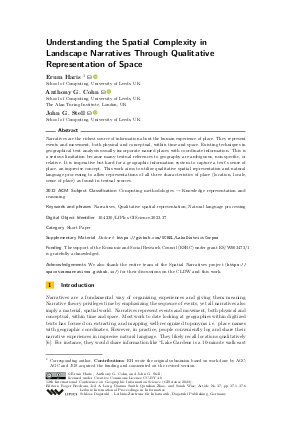Understanding the Spatial Complexity in Landscape Narratives Through Qualitative Representation of Space (Short Paper)
Authors
Erum Haris  ,
Anthony G. Cohn
,
Anthony G. Cohn  ,
John G. Stell
,
John G. Stell 
-
Part of:
Volume:
12th International Conference on Geographic Information Science (GIScience 2023)
Part of: Series: Leibniz International Proceedings in Informatics (LIPIcs)
Part of: Conference: International Conference on Geographic Information Science (GIScience) - License:
 Creative Commons Attribution 4.0 International license
Creative Commons Attribution 4.0 International license
- Publication Date: 2023-09-07
File

PDF
LIPIcs.GIScience.2023.37.pdf
- Filesize: 0.77 MB
- 6 pages
Document Identifiers
Subject Classification
ACM Subject Classification
- Computing methodologies → Knowledge representation and reasoning
Keywords
- Narratives
- Qualitative spatial representation
- Natural language processing
Metrics
- Access Statistics
-
Total Accesses (updated on a weekly basis)
0PDF Downloads0Metadata Views
Abstract
Narratives are the richest source of information about the human experience of place. They represent events and movement, both physical and conceptual, within time and space. Existing techniques in geographical text analysis usually incorporate named places with coordinate information. This is a serious limitation because many textual references to geography are ambiguous, non-specific, or relative. It is imperative but hard for a geographic information system to capture a text’s sense of place, an imprecise concept. This work aims to utilize qualitative spatial representation and natural language processing to allow representations of all three characteristics of place (location, locale, sense of place) as found in textual sources.
Cite As Get BibTex
Erum Haris, Anthony G. Cohn, and John G. Stell. Understanding the Spatial Complexity in Landscape Narratives Through Qualitative Representation of Space (Short Paper). In 12th International Conference on Geographic Information Science (GIScience 2023). Leibniz International Proceedings in Informatics (LIPIcs), Volume 277, pp. 37:1-37:6, Schloss Dagstuhl – Leibniz-Zentrum für Informatik (2023)
https://doi.org/10.4230/LIPIcs.GIScience.2023.37
BibTex
@InProceedings{haris_et_al:LIPIcs.GIScience.2023.37,
author = {Haris, Erum and Cohn, Anthony G. and Stell, John G.},
title = {{Understanding the Spatial Complexity in Landscape Narratives Through Qualitative Representation of Space}},
booktitle = {12th International Conference on Geographic Information Science (GIScience 2023)},
pages = {37:1--37:6},
series = {Leibniz International Proceedings in Informatics (LIPIcs)},
ISBN = {978-3-95977-288-4},
ISSN = {1868-8969},
year = {2023},
volume = {277},
editor = {Beecham, Roger and Long, Jed A. and Smith, Dianna and Zhao, Qunshan and Wise, Sarah},
publisher = {Schloss Dagstuhl -- Leibniz-Zentrum f{\"u}r Informatik},
address = {Dagstuhl, Germany},
URL = {https://drops.dagstuhl.de/entities/document/10.4230/LIPIcs.GIScience.2023.37},
URN = {urn:nbn:de:0030-drops-189323},
doi = {10.4230/LIPIcs.GIScience.2023.37},
annote = {Keywords: Narratives, Qualitative spatial representation, Natural language processing}
}
Author Details
Funding
The support of the Economic and Social Research Council (ESRC) under grant ES/W003473/1 is gratefully acknowledged.
Acknowledgements
We also thank the entire team of the Spatial Narratives project (https://spacetimenarratives.github.io/) for their discussions on the CLDW and this work.
Supplementary Materials
References
- John Agnew and David N. Livingstone. The SAGE Handbook of Geographical Knowledge. SAGE Publications Ltd, London, 2011. URL: https://doi.org/10.4135/9781446201091.
- Eliseo Clementini. A conceptual framework for modelling spatial relations. Information Technology and Control, 48:5-17, 2019. URL: https://doi.org/10.5755/j01.itc.48.1.22246.
- Christopher Elliott Donaldson, Ian N. Gregory, and Joanna E. Taylor. Implementing corpus analysis and gis to examine historical accounts of the english lake district. in: Historical atlas. In Peter Bol, editor, Historical atlas: its concepts and methodologies, pages 152-172. Northeast Asian History Foundation, Seoul, 2017. URL: https://eprints.lancs.ac.uk/id/eprint/81425/.
- Ignatius Ezeani, Paul Rayson, and Ian N. Gregory. Extracting imprecise geographical and temporal feferences from journey narratives. In Proceedings of Text2Story — Sixth Workshop on Narrative Extraction From Texts, 2023. URL: https://ceur-ws.org/.
- Erum Haris, Keng Hoon Gan, and Tien-Ping Tan. Spatial information extraction from travel narratives: Analysing the notion of co-occurrence indicating closeness of tourist places. Journal of Information Science, 46(5):581-599, 2020. URL: https://doi.org/10.1177/0165551519837188.
- Gregor Josseź, Klaus Arthur Schmid, Andreas Züfle, Georgios Skoumas, Matthias Schubert, Matthias Renz, Dieter Pfoser, and Mario A. Nascimento. Knowledge extraction from crowdsourced data for the enrichment of road networks. Geoinformatica, 21(4):763-795, 2017. URL: https://doi.org/10.1007/s10707-017-0306-1.
- Parisa Kordjamshidi, Martijn Van Otterlo , and Marie-Francine Moens. Spatial role labeling: Towards extraction of spatial relations from natural language. ACM Trans. Speech Lang. Process., 8(3), 2011. URL: https://doi.org/10.1145/2050104.2050105.
- Parisa Kordjamshidi, Martijn Otterlo, and Marie-Francine Moens. From language towards formal spatial calculi. In Proceedings of the Workshop on Computational Models of Spatial Language Interpretation at Spatial Cognition, volume 620, pages 17-24, 2010. URL: http://ceur-ws.org/Vol-620.
- Molly Miranker and Alberto Giordano. Text mining and semantic triples: Spatial analyses of text in applied humanitarian forensic research. Digital Geography and Society, 1:100005, 2020. URL: https://doi.org/10.1016/j.diggeo.2020.100005.
- Patricia Murrieta-Flores, Mariana Favila-Vázquez, and Aban Flores-Morán. Spatial humanities 3.0: Qualitative spatial representation and semantic triples as new means of exploration of complex indigenous spatial representations in sixteenth century early colonial mexican maps. International Journal of Humanities and Arts Computing, 13(1-2):53-68, 2019. URL: https://doi.org/10.3366/ijhac.2019.0231.
- Space Time Narratives Project. Understanding imprecise space and time in narratives through qualitative representations, reasoning, and visualisation. https://spacetimenarratives.github.io/, 2023.
- Robert Smail, Ian N.Gregory, and Joanna E.Taylor. Qualitative geographies in digital texts: Representing historical spatial identities in the lake district. International Journal of Humanities and Arts Computing, 13(1-2):28-38, 2019. URL: https://doi.org/10.3366/ijhac.2019.0229.
- Joanna E. Taylor and Ian N. Gregory. Deep Mapping the Literary Lake District. Bucknell University Press, 2022. URL: https://doi.org/10.2307/j.ctv2v55bsf.
